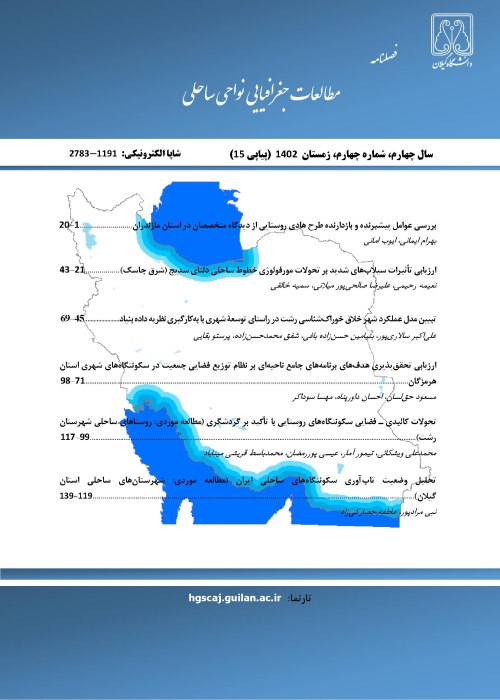Measuring and Evaluating the Level of Urban Creativity Based on the Iranian-Islamic Components in Dezful City
From the perspective of cultural geography, Iranian cities with the benefit of worldview and Iranian Islamic culture have the necessary talent to achieve urban creativity. If the conditions are right, Iranian cities will be able to take effective steps to achieve a creative Iranian-Islamic city in competition with other cities in the world. Therefore, the main purpose of this study is to measure and evaluate the level of urban creativity based on the Iranian-Islamic components in the city of Dezful. It was applied research in terms of purpose and descriptive-analytical-comparative in terms of method and nature. The data collection method was the library (statistics and upstream documents) and survey (questionnaire), which were analyzed using the Mabak technique. The results showed that districts 1 and 2, with 0.323 and 0.030, respectively, have the highest rate of urban creativity, i.e., the conditions for the development of urban creativity and also the adoption of creative city conditions based on Iranian-Islamic components, and district 3. with 0/239 was in a deprived situation, i.e., the need to reform and improve the planning methods of the creative city based on Iranian-Islamic principles. Extended Abstract Introduction The Islamic Iranian city needs creative organizations, creative political culture, creative leadership, multi-level and public participation, and active social participation to promote creativity and benefit from the advantages of the creative city. In Iranian-Islamic culture, the city is a comprehensive concept. It consists of various cultural, social, economic, historical, and natural dimensions that result from the interaction among these factors and the set of their effects and outcomes, shaping its structure. The city of Dezful, as one of Iran's original and historic cities, has a unique identity. The most important factors shaping the city's identity are the Dez River, historic bridges, historic mosques, religious monuments, handicrafts, and Islamic features. Also, in Islamic cities, the emphasis on urban creativity and Iranian-Islamic components and characteristics is one of the most important goals of optimal and sustainable urban development.MethodologyIt was applied research in terms of purpose and descriptive-analytical-comparative in terms of method and nature. The data collection method was the library (statistics and upstream documents) and survey (questionnaire), which were analyzed using the Mabak technique. After studying the theoretical foundations and background of research related to the evaluation of urban creativity, the components were extracted in the form of dimensions of urban creativity with an emphasis on the Iranian-Islamic basis. Accordingly, the proposed criteria have been evaluated by local elites. Due to the uncertainty of the number of experts in the field under study, a purposeful sampling and questionnaire survey was performed among 35 people. Then, the collected data were evaluated using SPSS software. The Cronbach's alpha test was used to measure the reliability of the research instrument (α=0.847). Also, the face and content validity tests were used to test the validity. The status of urban creativity was assessed based on the Iranian-Islamic components of the regions, using a t-test. In the second stage, the data was entered into the Excel environment. The urban areas were measured and ranked in terms of urban creativity using the Mabak technique and its process.Results and discussionUsing the MABAC technique, the distance matrix of the urban creativity index has been calculated based on Iranian-Islamic components in urban areas of Dezful. Distance analysis of options has shown that in terms of the creative class, region 2 (0.078) had the highest enjoyment in urban creativity, and region 3 (-0.042) had the least enjoyment in urban creativity. Regarding cultural and religious creativity, region 2 (0.105) had the most, and region 3 (-0.125) had the least urban creativity. Regarding historical creativity, region 2 (0.098) had the most, and region 1 (-0.082) had the least amount of urban creativity based on Iranian-Islamic components. Regarding ecological creativity, region 2 had the most with (0.042), and region 1 had the least with (-0.038) in urban creativity. Regarding economic creativity, region 3 has the highest, and region 2 (-0.041) had the lowest level of urban creativity. Regarding social creativity, region 2 has the highest, and region 1 has the lowest value in urban creativity. Regarding design and architecture creativity, region 2 has the highest urban creativity, and region 3 has the lowest urban creativity based on Iranian-Islamic components. And finally, about the distributing communication creativity in urban areas of Dezful; region 3 with 0.050 in the best and most enjoyable state and region 2 in the worst urban creativity is based on Iranian-Islamic components.ConclusionFinally, according to the results and based on the combination of indicators, it can be said that regions 2 and 1 have the highest amount of urban creativity based on the Iranian-Islamic components, respectively. Region 3, with a value of -0.239, is deprived of urban creativity indicators and distribution conditions based on Iranian-Islamic components. Therefore, it can be said that comparative analysis and indicators of urban creativity indicators in the urban areas of Dezful are distributed unbalanced, and it is necessary to adopt operational and managerial solutions in each of the key indicators to prevent polarization of facilities. Facilities and services in urban areas should also be prohibited in terms of urban creativity based on Iranian-Islamic components.FundingThere is no funding support.Authors’ Contribution Authors contributed equally to the conceptualization and writing of the article. All of the authors approved the content of the manuscript and agreed on all aspects of the workConflict of InterestAuthors declared no conflict of interest.Acknowledgments We are grateful to all the persons for scientific consulting in this paper.
- حق عضویت دریافتی صرف حمایت از نشریات عضو و نگهداری، تکمیل و توسعه مگیران میشود.
- پرداخت حق اشتراک و دانلود مقالات اجازه بازنشر آن در سایر رسانههای چاپی و دیجیتال را به کاربر نمیدهد.



